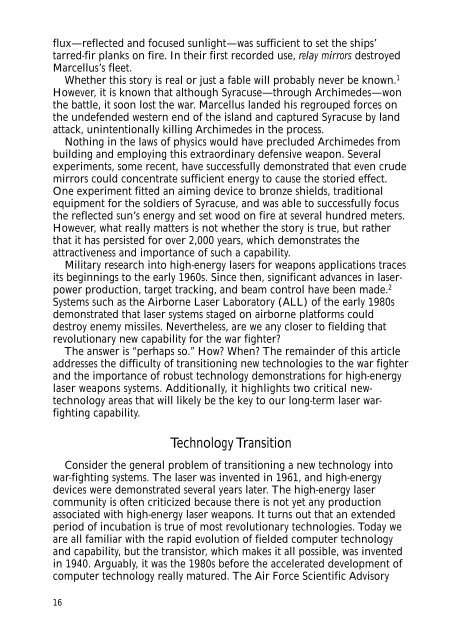presentation departments reproduced
Spring 2004 - Air and Space Power Journal - Air Force Link
Spring 2004 - Air and Space Power Journal - Air Force Link
- No tags were found...
Create successful ePaper yourself
Turn your PDF publications into a flip-book with our unique Google optimized e-Paper software.
flux—reflected and focused sunlight—was sufficient to set the ships’<br />
tarred-fir planks on fire. In their first recorded use, relay mirrors destroyed<br />
Marcellus’s fleet.<br />
Whether this story is real or just a fable will probably never be known. 1<br />
However, it is known that although Syracuse—through Archimedes—won<br />
the battle, it soon lost the war. Marcellus landed his regrouped forces on<br />
the undefended western end of the island and captured Syracuse by land<br />
attack, unintentionally killing Archimedes in the process.<br />
Nothing in the laws of physics would have precluded Archimedes from<br />
building and employing this extraordinary defensive weapon. Several<br />
experiments, some recent, have successfully demonstrated that even crude<br />
mirrors could concentrate sufficient energy to cause the storied effect.<br />
One experiment fitted an aiming device to bronze shields, traditional<br />
equipment for the soldiers of Syracuse, and was able to successfully focus<br />
the reflected sun’s energy and set wood on fire at several hundred meters.<br />
However, what really matters is not whether the story is true, but rather<br />
that it has persisted for over 2,000 years, which demonstrates the<br />
attractiveness and importance of such a capability.<br />
Military research into high-energy lasers for weapons applications traces<br />
its beginnings to the early 1960s. Since then, significant advances in laserpower<br />
production, target tracking, and beam control have been made. 2<br />
Systems such as the Airborne Laser Laboratory (ALL) of the early 1980s<br />
demonstrated that laser systems staged on airborne platforms could<br />
destroy enemy missiles. Nevertheless, are we any closer to fielding that<br />
revolutionary new capability for the war fighter?<br />
The answer is “perhaps so.” How? When? The remainder of this article<br />
addresses the difficulty of transitioning new technologies to the war fighter<br />
and the importance of robust technology demonstrations for high-energy<br />
laser weapons systems. Additionally, it highlights two critical newtechnology<br />
areas that will likely be the key to our long-term laser warfighting<br />
capability.<br />
Technology Transition<br />
Consider the general problem of transitioning a new technology into<br />
war-fighting systems. The laser was invented in 1961, and high-energy<br />
devices were demonstrated several years later. The high-energy laser<br />
community is often criticized because there is not yet any production<br />
associated with high-energy laser weapons. It turns out that an extended<br />
period of incubation is true of most revolutionary technologies. Today we<br />
are all familiar with the rapid evolution of fielded computer technology<br />
and capability, but the transistor, which makes it all possible, was invented<br />
in 1940. Arguably, it was the 1980s before the accelerated development of<br />
computer technology really matured. The Air Force Scientific Advisory<br />
16
















